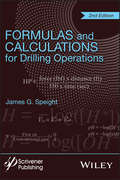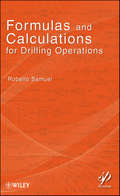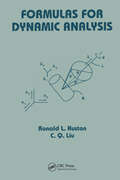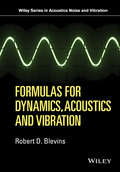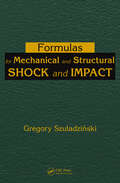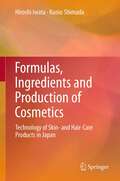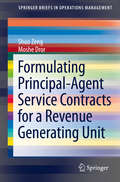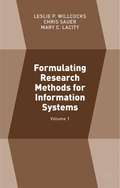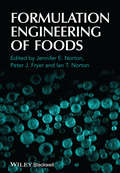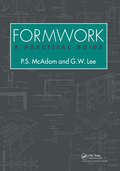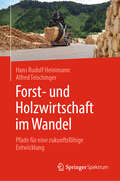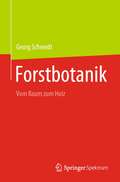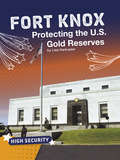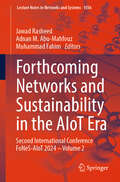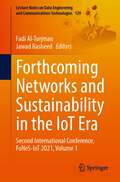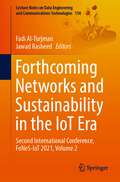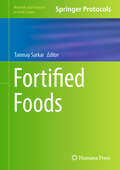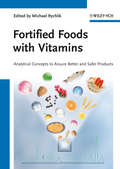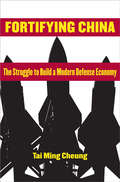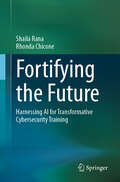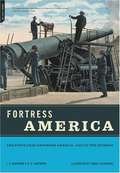- Table View
- List View
Formulas and Calculations for Drilling Operations
by James G. SpeightPresented in an easy-to-use format, this second edition of Formulas and Calculations for Drilling Operations is a quick reference for day-to-day work out on the rig. It also serves as a handy study guide for drilling and well control certification courses. Virtually all the mathematics required on a drilling rig is here in one convenient source, including formulas for pressure gradient, specific gravity, pump, output, annular velocity, buoyancy factor, and many other topics. Whether open on your desk, on the hood of your truck at the well, or on an offshore platform, this is the only book available that covers the gamut of the formulas and calculations for petroleum engineers that have been compiled over decades. Some of these formulas and calculations have been used for decades, while others are meant to help guide the engineer through some of the more recent breakthroughs in the industry’s technology, such as hydraulic fracturing and enhanced oil recovery. There is no other source for these useful formulas and calculations that is this thorough. An instant classic when the first edition was published, the much-improved revision is even better, offering new information not available in the first edition, making it as up-to-date as possible in book form. Truly a state-of-the-art masterpiece for the oil and gas industry, if there is only one book you buy to help you do your job, this is it!
Formulas and Calculations for Drilling Operations, 1st Edition
by Robello SamuelPresented in an easy-to-use format, Formulas and Calculations for Drilling Operations is a quick reference for day-to-day work out on the rig. It also serves as a handy study guide for drilling and well control certification courses. Virtually all the mathematics required on a drilling rig is here in one convenient source, including formulas for pressure gradient, specific gravity, pump, output, annular velocity, buoyancy factor, and many other topics.
Formulas for Dynamic Analysis (Mechanical Engineering)
by Ronald Huston C Q Liu"Explains and summarizes the fundamental derivations, basic and advanced concepts, and equations central to the field of dynamics. Chapters stand as self-study guides-containing tables, summaries of relevant equations, cross references, and illustrative examples. Utilizes Kane's equations and associated methods for the study of large and complex mu
Formulas for Dynamics, Acoustics and Vibration
by Robert D. BlevinsWith Over 60 tables, most with graphic illustration, and over 1000 formulas, Formulas for Dynamics, Acoustics, and Vibration will provide an invaluable time-saving source of concise solutions for mechanical, civil, nuclear, petrochemical and aerospace engineers and designers. Marine engineers and service engineers will also find it useful for diagnosing their machines that can slosh, rattle, whistle, vibrate, and crack under dynamic loads.
Formulas for Dynamics, Acoustics and Vibration (Wiley Series in Acoustics Noise and Vibration)
by Robert D. BlevinsWith Over 60 tables, most with graphic illustration, and over 1000 formulas, Formulas for Dynamics, Acoustics, and Vibration will provide an invaluable time-saving source of concise solutions for mechanical, civil, nuclear, petrochemical and aerospace engineers and designers. Marine engineers and service engineers will also find it useful for diagnosing their machines that can slosh, rattle, whistle, vibrate, and crack under dynamic loads.
Formulas for Mechanical and Structural Shock and Impact
by Gregory SzuladzinskiIn dealing with extreme loads on structures, simple approximations of key variables can indicate if there is a threat of collapse. The ability to determine such variables early on strongly impacts the decisions about the engineering approach to adopt. Formulas for Mechanical and Structural Shock and Impact is a self-contained and concise presentati
Formulas, Ingredients and Production of Cosmetics
by Hiroshi Iwata Kunio ShimadaToday, young cosmetics researchers who have completed their graduate studies and have entered a cosmetics company are put through several years of training before they become qualified to design cosmetics formulations themselves. They are trained so that they can design formulas not by a process of logic but by heart, like craftsmen, chefs, or carpenters. This kind of training seems a terrible waste of labor and time. To address this issue and allow young scientists to design novel cosmetics formulations, effectively bringing greater diversity of innovation to the industry, this book provides a key set of skills and the knowledge necessary for such pursuits. The volume provides the comprehensive knowledge and instruction necessary for researchers to design and create cosmetics products. The book's chapters cover a comprehensive list of topics, which include, among others, the basics of cosmetics, such as the raw materials of cosmetics and their application; practical techniques and technologies for designing and manufacturing cosmetics, as well as theoretical knowledge; emulsification; sensory evaluations of cosmetic ingredients; and how to create products such as soap-based cleansers, shampoos, conditioners, creams, and others. The potential for innovation is great in Japan's cosmetics industry. This book expresses the hope that the high level of dedicated research continues and proliferates, especially among those who are innovators at heart.
Formulating Principal-Agent Service Contracts for a Revenue Generating Unit
by Shuo Zeng Moshe DrorThis book examines contractual options for a performance based contract between an owner of a revenue generating unit and a repair agent for such unit. The framework of the analysis is that of economists' principal-agent problem. The contractual options of a principal and an agent are modeled as a Markov process with an undetermined time horizon. For a risk neutral principal, the authors identify the conditions under which a principal contracts with a risk-neutral, risk-averse, or risk-seeking agent and derive the principal's optimal offer together with the agent's optimal service capacity response. In essence, the book provides an extensive formulating analysis of principal-agent contracts given any exogenous parameter values. Ultimately a small number of formulas cover a large spectrum of principal-agent conditions.
Formulating Research Methods for Information Systems: Volume 1
by Leslie P. Willcocks Mary C. Lacity Chris SauerFormulating Research Methods for Information Systems.
Formulation
by Anne-Marie Pensé-LhéritierThis book deals with the formulation of industrial products Its field of application goes from food-processing industry to the industry of elastomers showing that the principles of development follow always the same methodology.
Formulation Engineering of Foods
by Ian T. Norton Jennifer E. Norton Peter J. FryerFormulation Engineering of Foods provides an in-depth look at formulation engineering approaches to food processing and product development of healthier, higher-performance foods. Through the use of eye-catching examples, such as low fat and low calorie chocolate, and salt reduction strategies in products like cheese and sauces, the book is at once easy to relate to and innovative. Presenting new methods and techniques for engineering food products, this book is cutting edge and as food formulation is a new method of food science, this is a timely publication in the field. All three editors are based in the University of Birmingham, base of the largest Chemical Engineering-based food research group in the UK, incorporating research into structured foods, flavour delivery and food hygiene. Research in food processing is carried out in partnership with key companies such as Nestlé, Unilever and Cadbury, as well as through funding from research councils and DEFRA. Joint research and collaboration has been carried out with Food Science departments at Nottingham, Leeds and Reading.
Formulation Simplified: Finding the Sweet Spot through Design and Analysis of Experiments with Mixtures
by Mark J. Anderson Patrick J. Whitcomb Martin A. BezenerMany chemists – especially those most brilliant in their field – fail to appreciate the power of planned experimentation. They dislike the mathematical aspects of statistical analysis. In addition, these otherwise very capable chemists also dismissed predictive models based only on empirical data. Ironically, in the hands of subject matter experts like these elite chemists, the statistical methods of mixture design and analysis provide the means for rapidly converging on optimal compositions. What differentiates Formulation Simplified from the standard statistical texts on mixture design is that the authors make the topic relatively easy and fun to read. They provide a whole new collection of insighful original studies that illustrate the essentials of mixture design and analysis. Solid industrial examples are offered as problems at the end of many chapters for those who are serious about trying new tools on their own. Statistical software to do the computations can be freely accessed via a web site developed in support of this book.
Formwork: A practical guide
by Geoffrey LeeTo optimise formwork costs and minimise the time for its construction, the contractor needs to understand the guiding principles of safe and efficient formwork construction. He must also have some insight into the relative merits of the various methods, and should appreciate the practical details of formwork construction.
Forst- und Holzwirtschaft im Wandel: Pfade für eine zukunftsfähige Entwicklung
by Hans Rudolf Heinimann Alfred TeischingerDas vorliegende Buch bietet eine Auslegeordnung, wie sich die Forst- und Holzwirtschaft Mitteleuropas orientieren kann, um die Nachhaltigkeits- und Klimawende mitzugestalten und zu einer Bioökonomie und Kreislaufwirtschaft beizutragen. Die Leitidee des Buches ist es, Optionen darzustellen und dies in der Absicht, die Vielfalt des Denkens und Handelns zu inspirieren. Vielfalt ist eine Voraussetzung, um mit unsicheren und unerwarteten Ereignissen, mit denen wir vermehrt konfrontiert sein werden, umgehen zu können. Das Buch analysiert, was die Leitbilder und Konzepte, welche den Nachhaltigkeits-, den Klima- sowie den sozialen Wandel prägen, für den Forst- und Holzsektor bedeuten. Es stellt danach die Hindernisse, welche die angestrebten Wenden behindern, und die „objektiven Realitäten“ dar, von denen eine Anpassung des Forst- und Holzsektors ausgehen muss. Die Pfade einer zukunftsfähigen Entwicklung beschreiben das wald- und holzspezifische Management des Kohlenstoffkreislaufes, die Weiterentwicklung des sozialen, institutionellen Arrangements, die Weiterentwicklung der Waldbausysteme sowie die Zukunft der stofflichen und energetischen Nutzung von Holz. Das Spektrum bisheriger Beiträge zum aktuellen Wandel sowie zu den Erwartungen und Anforderungen an Lösungen ist sehr breit und verkörpert die jeweils sehr spezifische Sichtweise einzelner Interessensgruppen. Dieses Buch ist ein Beitrag, Licht in das objektive Ödland, das in den letzten Jahren entstanden ist, zu werfen, und neben der Biodiversität in Wald und Natur auch die Diversität der Ideen zur erfolgreichen Bewältigung des Wandels zu stimulieren.
Forstbotanik: Vom Baum zum Holz
by Georg SchwedtDieses Buch schlägt für geschichtlich wie auch an der Natur interessierte Leserinnen und Leser den Bogen von der Historie, der Entstehung der Forstbotanik und der Entwicklung von Xylotheken bis zu den heutigen waldpädagogischen Ansätzen. Im ersten Abschnitt lernen Sie die wichtigsten Waldbäume anhand historischer Quellen vom Keimling, den Wurzeln, der Knospe bis zur Frucht und bis zu ihrem Holz kennen. Die detaillierten Beschreibungen der forstlich relevanten Laub- und Nadelbäume enthalten die ganze Naturgeschichte des jeweiligen Baumes und benennen auch deren Schädlinge. Zugleich erfahren Sie, wie sich die Bewirtschaftung von Bäumen im Forstbetrieb von der reinen Ökonomie zur Ökologie unter Berücksichtigung der Nachhaltigkeit entwickelt hat. Einen zweiten Schwerpunkt bilden die Beschreibungen und Anleitungen zu einem Baum-Herbarium nach den historischen Vorbildern der Xylotheken, die noch heute in Naturkundemuseen zu bewundern sind. Die eigene Anlage eines solchen Baum-Herbariums (in buchförmigen Holzkästen) erfolgt über eine Vegetationsperiode. Sie ermöglicht es Ihnen, sich jederzeit über die Botanik des jeweiligen Baumes – u.a. zu Knospen, Blüten, Blättern (auch Herbstlaub), Früchten, Rinde und Holz – unabhängig von der Jahreszeit durch eigene Anschauung zu informieren, wozu auch die Digitalmikroskopie zum Einsatz kommt.
Fort Knox: Protecting the U.S. Gold Reserves (High Security)
by Lisa HarkraderThe United States keeps its gold safe at Fort Knox. How is this done? There are fences, locks, guards, and more. Learn more about this high-security place!
Forthcoming Networks and Sustainability in the AIoT Era: Second International Conference FoNeS-AIoT 2024 - Volume 1 (Lecture Notes in Networks and Systems #1035)
by Jawad Rasheed Muhammad Fahim Adnan M. Abu-MahfouzThis book introduces a groundbreaking approach to enhancing IoT device security, providing a comprehensive overview of its applications and methodologies. Covering a wide array of topics, from crime prediction to cyberbullying detection, from facial recognition to analyzing email spam, it addresses diverse challenges in contemporary society. Aimed at researchers, practitioners, and policymakers, this book equips readers with practical tools to tackle real-world issues using advanced machine learning algorithms. Whether you're a data scientist, law enforcement officer, or urban planner, this book is a valuable resource for implementing predictive models and enhancing public safety measures. It is a comprehensive guide for implementing machine learning solutions across various domains, ensuring optimal performance and reliability. Whether you're delving into IoT security or exploring the potential of AI in urban landscapes, this book provides invaluable insights and tools to navigate the evolving landscape of technology and data science. The book provides a comprehensive overview of the challenges and solutions in contemporary cybersecurity. Through case studies and practical examples, readers gain a deeper understanding of the security concerns surrounding IoT devices and learn how to mitigate risks effectively. The book's interdisciplinary approach caters to a diverse audience, including academics, industry professionals, and government officials, who seek to address the growing cybersecurity threats in IoT environments. Key uses of this book include implementing robust security measures for IoT devices, conducting research on machine learning algorithms for attack detection, and developing policies to enhance cybersecurity in IoT ecosystems. By leveraging advanced machine learning techniques, readers can effectively detect and mitigate cyber threats, ensuring the integrity and reliability of IoT systems. Overall, this book is a valuable resource for anyone involved in designing, implementing, or regulating IoT devices and systems.
Forthcoming Networks and Sustainability in the AIoT Era: Second International Conference FoNeS-AIoT 2024 - Volume 2 (Lecture Notes in Networks and Systems #1036)
by Jawad Rasheed Muhammad Fahim Adnan M. Abu-MahfouzThis book introduces a groundbreaking approach to enhancing IoT device security, providing a comprehensive overview of its applications and methodologies. Covering a wide array of topics, from crime prediction to cyberbullying detection, from facial recognition to analyzing email spam, it addresses diverse challenges in contemporary society. Aimed at researchers, practitioners, and policymakers, this book equips readers with practical tools to tackle real-world issues using advanced machine learning algorithms. Whether you're a data scientist, law enforcement officer, or urban planner, this book is a valuable resource for implementing predictive models and enhancing public safety measures. It is a comprehensive guide for implementing machine learning solutions across various domains, ensuring optimal performance and reliability. Whether you're delving into IoT security or exploring the potential of AI in urban landscapes, this book provides invaluable insights and tools to navigate the evolving landscape of technology and data science. The book provides a comprehensive overview of the challenges and solutions in contemporary cybersecurity. Through case studies and practical examples, readers gain a deeper understanding of the security concerns surrounding IoT devices and learn how to mitigate risks effectively. The book's interdisciplinary approach caters to a diverse audience, including academics, industry professionals, and government officials, who seek to address the growing cybersecurity threats in IoT environments. Key uses of this book include implementing robust security measures for IoT devices, conducting research on machine learning algorithms for attack detection, and developing policies to enhance cybersecurity in IoT ecosystems. By leveraging advanced machine learning techniques, readers can effectively detect and mitigate cyber threats, ensuring the integrity and reliability of IoT systems. Overall, this book is a valuable resource for anyone involved in designing, implementing, or regulating IoT devices and systems.
Forthcoming Networks and Sustainability in the IoT Era: Second International Conference, FoNeS-IoT 2021, Volume 1 (Lecture Notes on Data Engineering and Communications Technologies #129)
by Fadi Al-Turjman Jawad RasheedThis book aims to provide a platform to the researchers and practitioners from both academia and industry to meet and share their experience and knowledge. Forthcoming Networks and Sustainability in the IoT Era (FoNeS-IoT), Volume 1 & 2, aims to bring together researchers and professionals to exchange ideas on the advancements in technology, application areas for advanced communication systems and development of new services, and facilitate a tremendous growth of new devices and smart things that need to be connected to the Internet through a variety of wireless technologies. Parallel to this, new capabilities such as pervasive sensing, multimedia sensing, machine learning, deep learning, unmanned aerial vehicles, cloud and edge computing, energy efficiency/harvesting, and computing power open the way to new domains, services, and business models beyond the traditional mobile Internet. The new areas in turn come with various requirements in terms of reliability, quality of service, and energy efficiency. These are only some examples of the challenges that are of interest to researchers in Forthcoming Networks and Sustainability in the IoT Era (FoNeS-IoT). It will explore the latest developments, innovations, and best practices within the IoT and the impact it has on industries including: manufacturing, transport, supply chain, communication, government, legal sectors, financial services, energy utilities, insurance, health care, retail, and many others. It provides opportunities for academicians and scientists along with professionals, policymakers, and practitioners from various fields in a global realm to present their research, contributions, and views, on one forum, and interact with members inside and outside their own particular disciplines. Papers describing applications of IoT in e-Health, Smart Systems & Management, Communication, and Education are also included, but the focus is mainly on how new and novel techniques advance the performance in application areas, rather than a presentation of yet another application of conventional tool. Papers on such applications describe a principled solution, emphasize its novelty, and present an in-depth evaluation of the techniques being exploited.
Forthcoming Networks and Sustainability in the IoT Era: Second International Conference, FoNeS-IoT 2021, Volume 2 (Lecture Notes on Data Engineering and Communications Technologies #130)
by Fadi Al-Turjman Jawad RasheedThis book aims to provide a platform to the researchers and practitioners from both academia and industry to meet and share their experience and knowledge. Forthcoming Networks and Sustainability in the IoT Era (FoNeS-IoT), Volume 1 & 2, aims to bring together researchers and professionals to exchange ideas on the advancements in technology, application areas for advanced communication systems and development of new services, and facilitate a tremendous growth of new devices and smart things that need to be connected to the Internet through a variety of wireless technologies. Parallel to this, new capabilities such as pervasive sensing, multimedia sensing, machine learning, deep learning, unmanned aerial vehicles, cloud and edge computing, energy efficiency/harvesting, and computing power open the way to new domains, services, and business models beyond the traditional mobile Internet. The new areas in turn come with various requirements in terms of reliability, quality of service, and energy efficiency. These are only some examples of the challenges that are of interest to researchers in Forthcoming Networks and Sustainability in the IoT Era (FoNeS-IoT). It will explore the latest developments, innovations, and best practices within the IoT and the impact it has on industries including: manufacturing, transport, supply chain, communication, government, legal sectors, financial services, energy utilities, insurance, health care, retail, and many others.It provides opportunities for academicians and scientists along with professionals, policymakers, and practitioners from various fields in a global realm to present their research, contributions, and views, on one forum, and interact with members inside and outside their own particular disciplines. Papers describing applications of IoT in e-Health, Smart Systems & Management, Communication, and Education are also included, but the focus is mainly on how new and novel techniques advance the performance in application areas, rather than a presentation of yet another application of conventional tool. Papers on such applications describe a principled solution, emphasize its novelty, and present an in-depth evaluation of the techniques being exploited.
Fortified Foods (Methods and Protocols in Food Science)
by Tanmay SarkarThis volume details the newest breakthroughs that are changing how researchers think about fortified foods. Chapters guide readers through nanoemulsions, liposome encapsulation, cutting-edge extrusion processes, and genetic tweaks. Subsequent chapters investigate liposome encapsulation to deliver vitamins, iron biofortification in meat products, and enzymatic hydrolysis to enhance protein in dairy alternatives. Written in the format of the Methods and Protocols in Food Science series, the chapters include an introduction to the respective topic, list necessary materials and reagents, detail well established and validated methods for readily reproducible laboratory protocols and contain notes on how to avoid or solve typical problems. Authoritative and cutting-edge, Fortified Foods aims to highlight the scientific basis that backs each strategy, while also tackling the real-world hurdles of large-scale implementation.
Fortified Foods with Vitamins: Analytical Concepts to Assure Better and Safer Products
by Michael RychlikUnique in its review of modern analytical approaches to vitamin fortification, this book emphasizes fast, sensitive, and accurate methods, along with assays enabling the detection of various isomers and multiple vitamins. The expert contributors describe the concepts as well as analytical and assay methods to study fortification, along with applications to create better and safer foods. Taking into considerations regulatory matters, they include data on sampling and extraction methods, and discuss the various pros and cons of each. As a result, readers are able to determine, which type of analytical method is best suited for added vitamins. A practical guide for food chemists and technologists, as well as analytical laboratories and biochemists.
Fortifying China: The Struggle to Build a Modern Defense Economy
by Tai Ming CheungFortifying China explores the titanic struggle to turn China into an aspiring world-class military technological power. The defense economy is leveraging the country's vibrant civilian economy and gaining access to foreign sources of technology and know-how. Drawing on extensive Chinese-language sources, Tai Ming Cheung explains that this transformation has two key dimensions. The defense economy is being reengineered to break down bureaucratic barriers and reduce the role of the state, fostering a more competitive and entrepreneurial culture to facilitate the rapid diffusion and absorption of technology and knowledge. At the same time, the civilian and defense economies are being integrated to form a dual-use technological and industrial base.In Cheung's view, the Chinese authorities believe this strategy will play a key role in supporting long-term defense modernization. For China's neighbors and the United States, understanding China's technological, industrial, and military capabilities is critical to the formulation of economic and security policies. Fortifying China provides crucial insight into the impact of China's dual-use technology strategy. Cheung's "systems of innovation" framework considers the structure, dynamics, and performance of the defense economy from a systems-level perspective.
Fortifying the Future: Harnessing AI for Transformative Cybersecurity Training
by Shaila Rana Rhonda ChiconeThis comprehensive handbook explores how artificial intelligence is transforming cybersecurity training, with a specific focus on practical implementation strategies for organizations. The book examines AI-driven approaches including personalized learning systems, gamification techniques, and immersive training environments using virtual and augmented reality. It provides detailed guidance on creating adaptive learning programs that respond to individual learner needs while addressing emerging cybersecurity threats. Key topics include AI-powered personalization of training content, development of realistic threat scenarios, integration of VR/AR technologies for hands-on practice, and implementation of gamification elements to boost engagement. The book offers concrete strategies for organizations to leverage AI in building more effective and engaging cybersecurity training programs that adapt to evolving security challenges. This handbook distinguishes itself from existing cybersecurity literature by focusing specifically on AI's application in training and skill development, rather than general cybersecurity operations. It serves both as a practical guide for professionals implementing AI-driven training programs and as a valuable resource for researchers and educators in cybersecurity, artificial intelligence, and organizational learning.
Fortress America: The Forts That Defended America, 1600 To The Present
by J. E. KaufmannFrom the earliest colonial settlements to Cold War bunkers, the North American continent has been home to thousands of forts and fortress structures. Fortress America surveys the broad sweep of fortifications throughout North America-from seacoast forts of the late eighteenth century to wooden inland forts built to defend against Native American, English,French, or Spanish attack; from Civil War-era coastal and inland waterways forts to the Great Plains' forts of the Old West; from World War II subterranean bunkers to Cold Warconcrete missile silos. The text of Fortress America is complemented with never-before-published photographs, and extraordinary drawings, cut-aways, and diagrams illustrating the design and structure of American forts.
